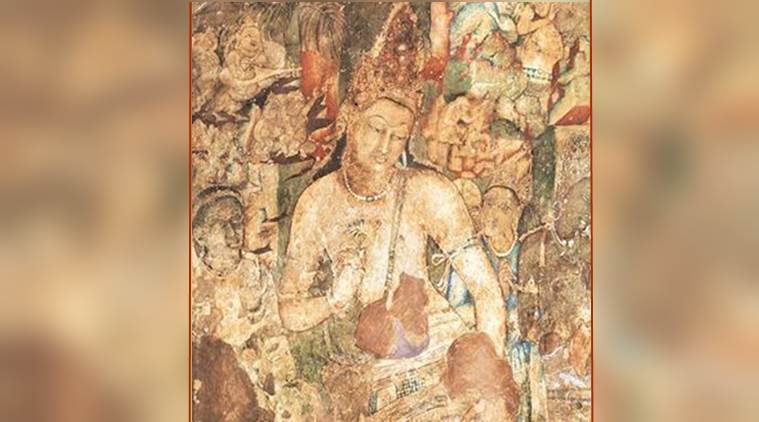- India
- International
Remains of the Day
After digitally restoring paintings at the Ajanta Caves for 27 years, artist-photographer Prasad Pawar presents his works in an exhibition for the first time

They are the oldest-known paintings of India, 2,000 years old, and are vanishing. This pertinent point about the artwork in Aurangabad’s famed Ajanta Caves drove Nashik-based photographer Prasad Pawar to devote the last 27 years of his life to study the works inside the Caves. He says that at this rate of deterioration, three generations later, there will be no paintings left inside this national treasure, which is also a UNESCO-designated World Heritage Site.
“The realisation came in 1989, during one of my visits to the caves as a student of art, when I observed that several patches in the paintings were missing. So while the famed life-sized painting Bodhisattva Padmapani didn’t have a stomach patch and left hand, some other idols don’t have an eye or a hand, or some other body part. One can’t connect to these works due to the missing sections,” recalls Pawar.
Since physical restoration of these paintings wasn’t feasible for him, Pawar approached the Archaeological Survey of India (ASI), which manages the monument, with a request to be allowed to photograph the works for digital restoration. Till the permission came, he continued visiting the caves and studying the paintings.
The Ajanta paintings are believed to have been made by Buddhist monks and represent scenes from the life of Buddha, heavily drawing from the Jataka tales. The Caves in general, and the paintings in particular, have undergone a deterioration lately. Overcrowding, a lack of awareness about handling delicate work and climate change have had adverse impact on the Caves. “If we keep allowing visitors indiscriminately to the monuments, be it the Ajanta Caves or the Taj, or allow construction in the vicinity, we are bound to lose the heritage eventually,” says 50-year-old Pawar.

He made Jataka tales as the basis of his restoration effort. And that took him on a 35,000-kilometre journey across India — through Maharashtra, Madhya Pradesh, Uttarakhand and Rajasthan — to study monuments that were as old as the Ajanta Caves. “I studied the colour palette and tried to understand the psychology of the artists of the time, especially how they created the characters, and tried to recreate all of that sitting at my computer in Nashik,” adds Pawar, who also credits technology for the same. A few years ago, he wrote a letter to Apple CEO Steve Jobs, thanking him that their technology helped him achieve his goal.
As of now, the team at PrasadPawar Foundation has digitally restored 1,44,40 sq inch of the works. The work involves three stages — photographic documentation of the paintings followed by digital colour correction and digital restoration of the missing patches in consonance with the original. Pawar is in Delhi these days to showcase his work in an exhibition titled “Glorious Ajanta”. As many as 70 of these digitally restored works have been printed on canvases for the exhibition, which include the iconic images of Padmapani, Vajrapani, Black Princess and many paintings from cave numbers 1, 2, 16 and 17, depicting scenes from the Jataka tales, such as Buddha giving sermons and other episodes of his life.
Pawar says that when a visitor goes inside the Ajanta Caves, he is allowed merely 10 minutes. In such a short span of time, nothing much can register. “Also, the light inside is so dim that one can barely read the paintings. So all that a trip to Ajanta offers is a cursory glance at what’s inside,” says Pawar. To illustrate this, he explains that it took him one year to observe the said image of Padmapani before he felt confident enough to have understood it for restoration. “My work is not fantasy, it’s recreation,” says the artist.
His extensive study of the paintings has also thrown up some revelations about the times through depictions of jewellery, costumes and architecture. “The paintings reveal that India had plenty of resources and wealth at that time as one can see gold mounted on the animals. In one scene, a dancing girl is shown wearing a silk blouse with sleeves made of sheer fabric. The skirt is made of a heavier fabric, as is evident from the fall. So we had all the fabrics of today even 2,000 years ago,” says Pawar.
Pawar’s work also assumes significance as no physical restoration of the cave paintings has been possible till date. So if it has to be done sometime in the future, his images will serve as a template for the ASI. “We have not been able to recreate the earth colours of 2,000 years ago,” says Prasad, adding that since it’s a world heritage site, Japan and France have also been working to recreate the colour but there has been no breakthrough.
“Since Ajanta paintings may not exist in due course, I’m now planning to create a museum in Maharashtra to show the ancient Indian art to the world,” says Pawar. Till that happens, he is in talks with the ICCR (which functions under the Ministry of External Affairs) to hold simultaneous shows of “Glorious Ajanta” around the world.
Buzzing Now
May 04: Latest News
- 01
- 02
- 03
- 04
- 05


































